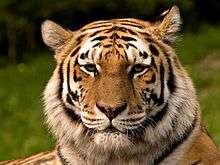Wildlife of Cambodia
Cambodia is home to a diverse array of wildlife. There are 212 mammal species, 536 bird species, 176 reptile species (including 89 subspecies),[1] 850 freshwater fish species (Tonlé Sap Lake area), and 435 marine fish species. Many of the country's species are recognized by the IUCN or World Conservation Union as threatened, endangered, or critically endangered due to deforestation and habitat destruction, poaching, the illegal wildlife trade, and farming, fishing, and forestry concessions. Intensive poaching may have already driven Cambodia's national animal, the kouprey, to extinction, and wild tigers, Eld's deer, wild water buffaloes and hog deer are at critically low numbers.
Wildlife in Cambodia includes dholes, elephants, deer (sambar, Eld's deer, hog deer and muntjac), wild oxen (banteng and gaur), panthers, bears, and tigers. Cormorants, cranes, ibises, parrots, green peafowl, pheasants, and wild ducks are also found, and species of venomous snakes and constrictors are numerous. Deforestation, mining activities, and unregulated hunting, have diminished the country’s wildlife diversity rapidly.
Cambodia also has many endangered species. Cambodia has 16 globally endangered species and two critically endangered species. Some of Cambodia's endangered species are the Asian elephant, Siamese crocodile, wild water buffalo, and the Germain's silver langur.
Much work is being done in this area to help conserve and protect Cambodia's unique wildlife. Wildlife conservation organizations operating in Cambodia include Conservation International, World Wildlife Fund, the Wildlife Conservation Society, Fauna and Flora International, BirdLife International, Wildlife Alliance, and many others.
Fauna
Animals native to Cambodia:
Mammals
- Agile gibbon
- Asian black bear
- Asian elephant
- Asian golden cat
- Banteng
- Clouded leopard
- Dhole
- Douc langur
- Eld's deer
- Gaur
- Hog badger
- Hog deer
- Indian muntjac
- Irrawaddy dolphin
- Kouprey
- Kting voar
- Lar gibbon
- Leopard cat
- Lesser false vampire bat
- Marbled cat
- Pileated gibbon
- Rice-field rat
- Sambar deer
- Serow
- Silvery lutung
- Sun bear
- Tiger
- Wild boar
- Wild water buffalo
Reptiles
- Asiatic softshell turtle
- Batagur baska
- Bengal monitor
- Blood python
- Burmese python
- Cantor's giant soft-shelled turtle
- False gharial
- Green sea turtle
- Hawksbill turtle
- Indotestudo elongata
- Leatherback sea turtle
- Manouria emys
- Pelochelys cantorii
- Ramphotyphlops braminus
- Reticulated python
- Saltwater crocodile
- Siamese crocodile which is a species critically endangered and on the IUCN Red List
- Water monitor
- Golden flying snake
- Asian vine snake
- Long-nosed whip snake
- Many-spotted cat snake
- Mangrove snake
- Dog-toothed cat snake
- Green cat snake
- Kukri snakes
- Radiated ratsnake
- White-lipped pit viper
- Large-eyed pit viper
- Mountain pit viper
- Malayan pit viper
- Russell's viper
- Monocled cobra
- Indochinese spitting cobra
- King cobra
- Banded krait
- Malayan krait
- Red-headed krait
- Red-tailed pipe snake
- Sunbeam snake
- Little file snake
- Elephant trunk snake
- Asian coral snakes
- Tentacled snake
- Sea snake
- Sea krait
Fish
- Asian arowana
- Barbus sp.
- Botia sp.
- Channa sp. (snakehead fishes)
- Danio sp.
- Labeo sp.
- Mekong freshwater stingray
- Mekong giant catfish
- Pangasius sp. (catfishes)
- Pangio sp. (Kuhli loach)
- Rasbora sp.
- Trichogaster sp.
Birds
Molluscs
Flora
Cambodia supports more than 8000 identified plant species, many of which are endemic to unique local ecosystems, such as the Tonlé Sap floodplain, forests of the Cardamom and Dâmrei mains, and higher elevations.[2]
- Cambodia's national flower is the rumdul flower, officially Mitrella mesnyi.
- The white cheesewood, also known as rumdul, is the official flower of Sisaket Province.
- Aquilaria crassna, or chankreussna, is a tree species valued for its perfume which is currently critically endangered.
See also
References
- ↑ Reptile Database, accessed 3 March 2013
- ↑ R. Jalonen; Choo, K.Y.; Hong, L.T.; Sim, H.C., (eds.) (2009). Forest genetic resources conservation and management: status in seven South and Southeast Asian countries. Bioversity International. pp. 3–. ISBN 978-967-5221-21-7. Cite uses deprecated parameter
|coauthors=(help)



.jpg)